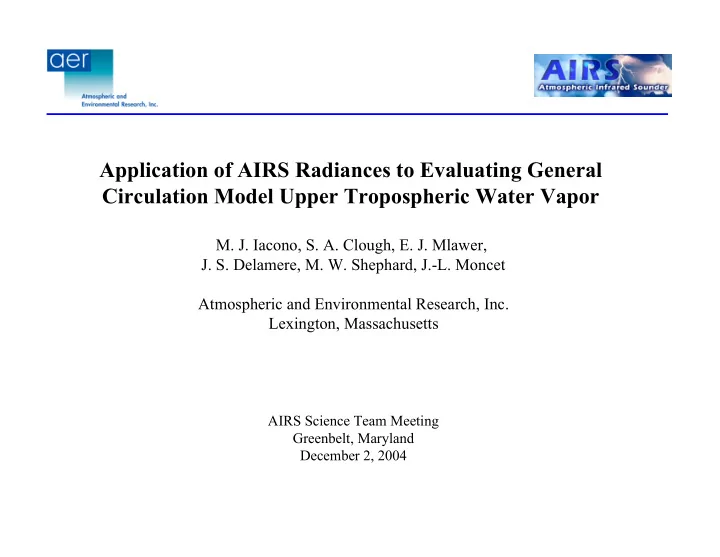

Application of AIRS Radiances to Evaluating General Circulation Model Upper Tropospheric Water Vapor M. J. Iacono, S. A. Clough, E. J. Mlawer, J. S. Delamere, M. W. Shephard, J.-L. Moncet Atmospheric and Environmental Research, Inc. Lexington, Massachusetts AIRS Science Team Meeting Greenbelt, Maryland December 2, 2004
Models and Databases Supported at AER Clough et al., JQSRT, (2005) www.rtweb.aer.com LBLRTM General line-by-line model CHARTS Multiple Scattering (Plane Parallel) MonoRTM LBL for limited spectral ranges (e.g. microwave) RRTM_LW LW Flux and Cooling Rate (broadband) • Standard Version • GCM Version (RRTMG_LW) RRTM_SW SW Flux and Cooling Rate (broadband) • Standard Version: DISORT • GCM Version: Two-Stream (RRTMG_SW) OSS Optimal Spectral Sampling • LW Region Databases • Continuum MT_CKD_1.1 • Line Parameters HITRAN+ • Solar Source Function Kurucz, Monochromatic & 1 cm -1
OSS Description Optimal Spectral Sampling (OSS) Model Features: • Efficient method for modeling narrow band radiances • Includes absorption from all major gases and many trace gases • Approximates radiance in a channel as a weighted sum of monochromatic radiances calculated at selected wavenumbers in the spectral interval • Can include instrument functions (OSS can model AIRS) • OSS attains accuracy close to LBLRTM • OSS about 100 times faster than LBLRTM • Currently being modified to include scattering calculations • More information available at www.rtweb.aer.com
Project Overview Objective: • To utilize AIRS spectral radiances for GCM evaluation by comparing modeled and observed radiances, with emphasis on upper tropospheric water vapor. Observations: • AIRS Level 3 cloud-cleared radiances • Focus on spectral elements or intervals relevant to water vapor • Earlier experiments utilized HIRS cloud-cleared radiances ( Bates et al .) General Circulation Model: • NCAR Community Atmosphere Model, CAM3; 2002-04 ensemble simulations • Separate proposed project will analyze NASA GISS ModelE Radiative Transfer: • RRTMG_LW and RRTMG_SW have been installed in CAM3 • OSS will be implemented in CAM3 to calculate spectral radiance • Evaluate accuracy of OSS and adapt it for application to GCMs
Comparison of OSS and LBLRTM to AIRS Radiance Spectrum
Comparison of OSS and LBLRTM to AIRS Radiance Spectrum
Comparison of OSS and LBLRTM to AIRS Radiance Spectrum
Comparison of OSS and LBLRTM for Set of 42 Diverse Profiles
Comparison of OSS and LBLRTM for Set of 42 Diverse Profiles
Comparison of OSS and LBLRTM for Set of 42 Diverse Profiles
GCM Evaluation With HIRS 6.7 µ m Water Vapor Channel GCM Experiment Description: • Analysis of NCAR CAM3 climate model upper tropospheric water vapor • Prescribed, monthly varying SSTs • Five-member ensemble simulation of 1980-1983; ensemble needed to determine level of GCM internal noise • Compare modeled and HIRS-observed CH04 to establish temperature accuracy and effectiveness of cloud-clearing in data • Examine CH12 to evaluate GCM water vapor GCM Radiative Transfer: • CAM3 modified to run with RRTMG_LW and RRTMG_SW • NOAA-7 HIRS radiances calculated with RRTM-like module • GCM evaluation more efficient with accurate radiative transfer
HIRS 6.7 µ m Water Vapor Channel GOES-10 6.7 µ m water vapor (CH12) image from CH 4: 675-732 cm -1 (Temperature) 1200 UTC 5 April 2002 centered over the equatorial eastern Pacific Ocean at 135° W (NASA-GSFC CH12: 1382-1572 cm -1 (Water Vapor) image, data from NOAA GOES).
Observed and Calculated HIRS CH04 Clear Sky Brightness Temperature
Observed - Calculated HIRS CH04 Clear Sky Brightness Temperature
Observed and Calculated HIRS CH12 Clear Sky Brightness Temperature
Observed - Calculated HIRS CH12 Clear Sky Brightness Temperature
Observed and Calculated HIRS CH12 Clear Sky Brightness Temp., 1982-1984
Summary • Objective: Examine spectral component of GCM radiative transfer; focus on evaluating GCM water vapor by comparing modeled and AIRS radiances. • OSS method provides accurate and efficient spectral radiances relative to LBLRTM; will be adapted for use in GCMs • HIRS CH12 brightness temperatures have been used to show GCM deficiencies in NCAR CAM3 upper tropospheric water vapor • Comparison to satellite radiance is an important diagnostic for GCMs to provide closure Future Work • Experiments will require AIRS Level 3 cloud-cleared radiances for spectral regions or elements to be decided • Proposed project will use this approach to examine NASA GISS ModelE
Recommend
More recommend